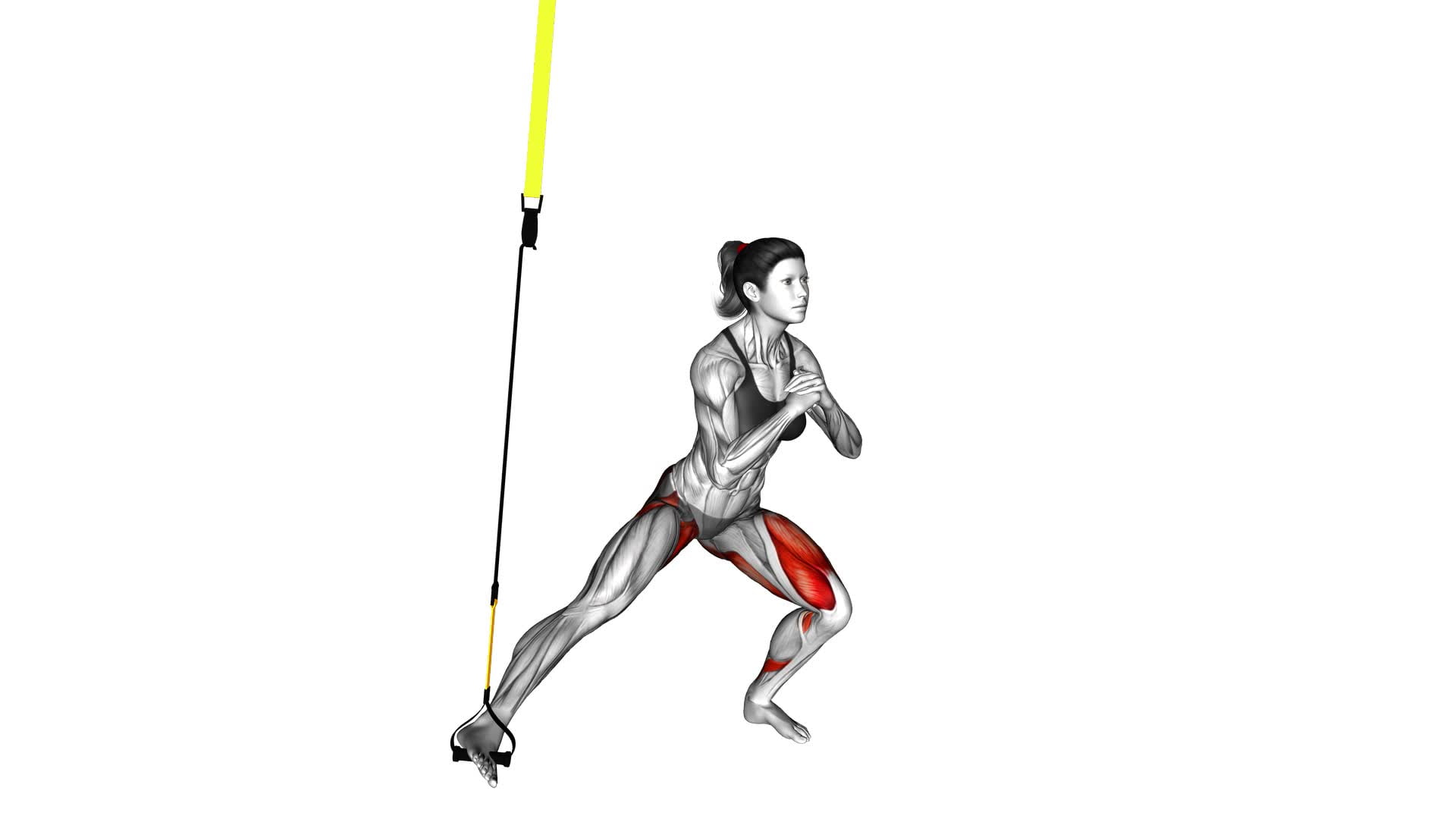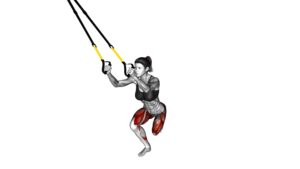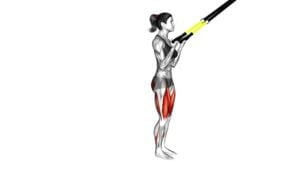Suspender Abduction Lunge (female) – Video Exercise Guide & Tips

Are you looking for a new exercise that targets your glutes and thighs? Look no further than the Suspender Abduction Lunge!
Watch This Exercise Video
This intense workout will help you strengthen and tone those muscles while improving your balance and stability.
In this video exercise guide, we provide step-by-step instructions and helpful tips to ensure you perform the exercise with proper form.
Get ready to take your fitness routine to the next level with the Suspender Abduction Lunge!
Key Takeaways
- The Suspender Abduction Lunge is highly effective for muscle activation and injury prevention.
- It targets and strengthens multiple muscle groups including the glutes, quadriceps, hamstrings, and hip abductors.
- Proper form and technique, along with gradual progression, are important for avoiding injuries and maximizing results.
- Incorporating proper pre-workout and post-workout nutrition, hydration, rest, and overall recovery strategies can enhance performance and promote muscle growth.
Benefits of the Suspender Abduction Lunge
Experience the numerous benefits of the Suspender Abduction Lunge. This exercise is highly effective in terms of muscle activation and injury prevention. By incorporating the Suspender Abduction Lunge into your workout routine, you can target and strengthen multiple muscle groups simultaneously. This exercise primarily activates the glutes, quadriceps, hamstrings, and hip abductors.
Muscle activation is crucial for building strength and achieving optimal performance. The Suspender Abduction Lunge effectively activates and engages these key muscle groups, helping you develop a strong lower body and improve overall athletic performance. Additionally, this exercise promotes muscle balance and stability, reducing the risk of imbalances and potential injuries.
Injury prevention is another significant benefit of the Suspender Abduction Lunge. By strengthening the muscles around the hips and thighs, you can enhance joint stability and minimize the chances of strains or other lower body injuries. This exercise also helps improve hip mobility, which is essential for proper movement mechanics and preventing injuries related to poor range of motion.
To ensure you reap the full benefits of the Suspender Abduction Lunge, it's important to maintain proper form and technique. Transitioning into the subsequent section, let's delve into the details of how to perform this exercise correctly and maximize its effectiveness.
Proper Form and Technique
To perform the Suspender Abduction Lunge with proper form and technique, follow these steps:
- Start by standing with your feet hip-width apart and your hands resting on your hips. This is your starting position.
- Take a step forward with your right foot, lunging down until your right knee is at a 90-degree angle. As you lower into the lunge, simultaneously lift your left leg out to the side, keeping it straight.
- Push through your right heel to return to the starting position, bringing your left leg back to the ground.
- Repeat the movement on the opposite side, stepping forward with your left foot and lifting your right leg out to the side.
Common misconceptions about the Suspender Abduction Lunge include the belief that it's only for women. In reality, this exercise can be beneficial for both men and women. Additionally, it's important to focus on maintaining proper form throughout the movement to prevent injuries. Keep your core engaged, chest lifted, and avoid letting your knees collapse inward.
Injury prevention techniques for the Suspender Abduction Lunge include starting with lighter weights or no weights at all to allow your body to adapt to the exercise. Gradually increase the weight as you become more comfortable with the movement. Additionally, listen to your body and stop if you experience any pain or discomfort. It's always important to consult with a healthcare professional before starting any new exercise routine.
Variations and Modifications
For additional challenge and variety, you can incorporate different variations and modifications into your Suspender Abduction Lunge routine. By trying out advanced lunge variations, you can take your workout to the next level and target specific muscle groups more effectively. Here are a few ideas to customize your exercise and maximize your results.
One advanced lunge variation is the walking lunge. Instead of staying stationary, you can take steps forward or backward while performing the abduction motion. This not only engages your glutes and thighs but also challenges your balance and coordination.
Another option is the reverse lunge. Instead of stepping forward, you step backward into the lunge position. This variation targets your hamstrings and glutes more intensively.
To focus on your inner thighs, you can try the lateral lunge. Instead of lunging forward or backward, you step to the side and lunge down. This modification helps tone and strengthen your adductor muscles.
If you want to incorporate some upper body work, you can hold dumbbells or kettlebells while performing the Suspender Abduction Lunge. This adds resistance and engages your arms, shoulders, and core.
Remember to start with proper form and gradually increase the difficulty level as you get stronger. Feel free to experiment with different variations and modifications to keep your workouts challenging and exciting.
Common Mistakes to Avoid
When performing the Suspender Abduction Lunge, it's important to be mindful of common mistakes to avoid. Here are four common mistakes to watch out for and tips on how to maintain proper technique:
- Leaning too far forward: One common mistake is leaning too far forward during the lunge. This can put excessive strain on your knees and increase the risk of injury. To avoid this, keep your upper body upright and engage your core muscles to maintain stability.
- Allowing your knee to collapse inwards: Another mistake is allowing your knee to collapse inwards as you lunge. This can also lead to knee pain and injury. To prevent this, focus on keeping your knee aligned with your toes throughout the movement. Engage your glutes and outer thigh muscles to help maintain proper alignment.
- Not going deep enough into the lunge: Some people tend to perform shallow lunges, missing out on the full benefits of the exercise. Make sure to take a big step forward and lower your body until your front thigh is parallel to the ground. This will help target your glutes and thighs effectively.
- Rushing through the exercise: Lastly, rushing through the Suspender Abduction Lunge can compromise your form and reduce its effectiveness. Take your time with each repetition, focusing on maintaining proper technique and control throughout the movement.
Tips for Getting the Most Out of Your Workout
To maximize your workout and get the most out of the Suspender Abduction Lunge, it's important to implement these helpful tips.
Along with regular exercise, proper nutrition is crucial for optimal workout performance and recovery. Fueling your body with the right nutrients before and after your workout can enhance your results and improve muscle recovery.
Prior to your workout, focus on consuming a balanced meal or snack that includes carbohydrates for energy, protein for muscle repair, and healthy fats for sustained energy. Some examples of pre-workout snacks include a banana with almond butter, Greek yogurt with berries, or a protein smoothie.
Additionally, staying hydrated is essential for performance and recovery, so be sure to drink plenty of water throughout the day.
After your workout, prioritize post-workout nutrition by consuming a combination of carbohydrates and protein to replenish glycogen stores and promote muscle repair. This could include a protein shake, a turkey and avocado wrap, or a chicken and quinoa salad.
Lastly, don't forget to incorporate rest and recovery days into your workout routine to allow your muscles to repair and grow. Getting enough sleep, stretching, and practicing stress management techniques can also support workout recovery.
Frequently Asked Questions
How Many Calories Can I Burn by Doing the Suspender Abduction Lunge?
You can burn a significant number of calories by doing the suspender abduction lunge. This exercise targets multiple muscle groups and increases your heart rate, which leads to calorie burn.
However, the exact number of calories burned depends on various factors such as your weight, intensity, and duration of the workout.
If you have knee problems, consider modifying the exercise by using a lower step or chair for support.
Always consult with a healthcare professional before starting any new exercise routine.
Is the Suspender Abduction Lunge Suitable for Beginners?
The suspender abduction lunge can be challenging for beginners. However, there are modifications you can try to make it more suitable for your fitness level.
If the exercise feels too difficult, you can start by performing a regular lunge without the suspension straps. This will help you build strength and stability before progressing to the suspender abduction lunge.
Additionally, there are alternative exercises like side lunges or standing leg lifts that can target similar muscles.
Can I Do the Suspender Abduction Lunge if I Have Knee Problems?
If you have knee problems, it's important to consider modification options for the suspender abduction lunge. This exercise can put strain on the knees, so it may not be suitable for you.
Instead, try alternative exercises that are easier on the knees, such as side leg lifts or clamshells. These exercises can still target the same muscles without causing discomfort or further injury to your knees.
How Often Should I Include the Suspender Abduction Lunge in My Workout Routine?
To maximize the benefits of including the suspender abduction lunge in your workout routine, aim for 2-3 sessions per week.
This exercise targets your glutes, hips, and thighs, helping to strengthen and tone those areas.
To add more challenge, you can try variations such as holding weights or adding a lateral movement.
Remember to listen to your body and modify the exercise if you have any knee problems.
Consistency and proper form are key for optimal results.
Can I Perform the Suspender Abduction Lunge Without Using Suspenders or Resistance Bands?
Yes, you can still perform the suspender abduction lunge without using suspenders or resistance bands. However, using suspenders or resistance bands provides added benefits by increasing the resistance and making the exercise more challenging.
If you don't have access to suspenders or resistance bands, you can try alternative modifications like using ankle weights or holding dumbbells to add resistance. These modifications will help target and strengthen your hip and glute muscles effectively.
Conclusion
In conclusion, the suspender abduction lunge is a highly effective exercise for strengthening the lower body and improving overall stability.
By following proper form and technique, you can maximize the benefits of this exercise and avoid common mistakes.
Additionally, incorporating variations and modifications can help tailor the exercise to your fitness level and goals.
Remember to listen to your body, stay consistent, and always consult a professional before starting any new exercise routine.

Author
Years ago, the spark of my life’s passion ignited in my mind the moment I stepped into the local gym for the first time. The inaugural bead of perspiration, the initial endeavor, the very first surge of endorphins, and a sense of pride that washed over me post-workout marked the beginning of my deep-seated interest in strength sports, fitness, and sports nutrition. This very curiosity blossomed rapidly into a profound fascination, propelling me to earn a Master’s degree in Physical Education from the Academy of Physical Education in Krakow, followed by a Sports Manager diploma from the Jagiellonian University. My journey of growth led me to gain more specialized qualifications, such as being a certified personal trainer with a focus on sports dietetics, a lifeguard, and an instructor for wellness and corrective gymnastics. Theoretical knowledge paired seamlessly with practical experience, reinforcing my belief that the transformation of individuals under my guidance was also a reflection of my personal growth. This belief holds true even today. Each day, I strive to push the boundaries and explore new realms. These realms gently elevate me to greater heights. The unique combination of passion for my field and the continuous quest for growth fuels my drive to break new ground.







